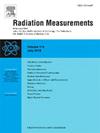在PADC中,沿不可蚀刻轨迹产生的孤立辐射损伤由两个羟基组成
IF 2.2
3区 物理与天体物理
Q2 NUCLEAR SCIENCE & TECHNOLOGY
引用次数: 0
摘要
本工作的目的是通过确定乙醚的损伤密度和羟基的形成密度来阐明PADC中不可蚀刻轨迹的损伤结构。用FT-IR光谱法测定了30 MeV和65 MeV质子束辐照前后PADC薄膜的损伤密度和形成密度。乙醚的损伤密度与羟基的形成密度之比约为1:2,这与能量低于6 MeV/u的质子和He离子的损伤密度之比基本一致。即使在抑制羟基形成密度的真空辐照下,该比值也几乎没有变化。可以假设,在PADC的一个重复单元内,由两个分离的羟基组成的损伤几乎不会改变其蚀刻性能。这种特定损伤的稳定和高密度形成将使更灵敏的探测器的发展成为可能。本文章由计算机程序翻译,如有差异,请以英文原文为准。
Isolated radiation damage created along un-etchable tracks in PADC consists of two hydroxyl groups
The objective of the present work is to clarify the damage structure along un-etchable tracks in PADC, by determining the damage density of ether as well as the formation density of hydroxyl group along them. Both the damage density and the formation density have been evaluated by means of FT-IR spectrometry on PADC films before and after the exposures to 30 MeV and 65 MeV proton beams with various fluence. The ratio of the damage density of ether to the formation density of hydroxyl group was about 1:2, which was almost identical to those for protons and He ions with energies of below 6 MeV/u. Futhermore, the ratio was hardly changed even in the case of in vacuum irradiation, where the formation density of hydroxyl group was suppressed. It can be assumed that damage consisting of two isolated hydroxyl groups within a single repeating unit of PADC is hardly to alter its etching properties. The stable and high density formation of such specific damage would enable the development of more sensitive detectors.
求助全文
通过发布文献求助,成功后即可免费获取论文全文。
去求助
来源期刊

Radiation Measurements
工程技术-核科学技术
CiteScore
4.10
自引率
20.00%
发文量
116
审稿时长
48 days
期刊介绍:
The journal seeks to publish papers that present advances in the following areas: spontaneous and stimulated luminescence (including scintillating materials, thermoluminescence, and optically stimulated luminescence); electron spin resonance of natural and synthetic materials; the physics, design and performance of radiation measurements (including computational modelling such as electronic transport simulations); the novel basic aspects of radiation measurement in medical physics. Studies of energy-transfer phenomena, track physics and microdosimetry are also of interest to the journal.
Applications relevant to the journal, particularly where they present novel detection techniques, novel analytical approaches or novel materials, include: personal dosimetry (including dosimetric quantities, active/electronic and passive monitoring techniques for photon, neutron and charged-particle exposures); environmental dosimetry (including methodological advances and predictive models related to radon, but generally excluding local survey results of radon where the main aim is to establish the radiation risk to populations); cosmic and high-energy radiation measurements (including dosimetry, space radiation effects, and single event upsets); dosimetry-based archaeological and Quaternary dating; dosimetry-based approaches to thermochronometry; accident and retrospective dosimetry (including activation detectors), and dosimetry and measurements related to medical applications.
 求助内容:
求助内容: 应助结果提醒方式:
应助结果提醒方式:


